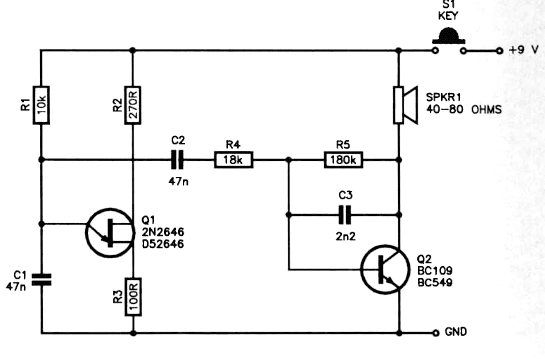A UJT Morse code practice oscillator is a simple electronic circuit that generates audio tones. Ham radio operators and electronics beginners use this circuit to practice Morse code.

How Does This Circuit Work?
This UJT Morse code practice oscillator circuit centers around a Unijunction Transistor (UJT), specifically Q1 (which can be a 2N2646 or D52646). It’s configured as a classic UJT oscillator, generating a sawtooth waveform across Capacitor C1 (47nF). This waveform operates at a frequency of a few hundred Hertz, providing the core tone for your Morse practice.
The generated sawtooth waveform then feeds into the base of Q2 (a BC109 or BC549), which acts as the output amplifier. Capacitor C2 (47nF) and Resistor R4 (18kΩ) handle the DC decoupling and signal transfer to Q2’s base. Resistor R5 (180kΩ) provides the necessary bias for Q2 to operate correctly.
For the output, you can connect a high-impedance speaker (SPKR1, 40-80 ohms) directly to the circuit. Alternatively, if you prefer a more personal practice session, you can use low-impedance dynamic headphones. Just a friendly warning: the sound can be quite prominent, so be mindful of those around you!
The key contacts (S1) are cleverly integrated into the circuit, placed in series with the positive 9V battery supply. This allows you to easily make and break the circuit, producing your Morse code signals.
Finally, Capacitor C3 (2n2F) plays an important role in refining the audio output. It helps to smooth out some of the inherent roughness in the sawtooth note produced by the UJT oscillator, resulting in a cleaner and more pleasant tone for your practice sessions.
UJT (Unijunction Transistor) Alternatives for Q1 (D5246)
Direct UJT Replacements are 2N2646 – Most common and widely available and UJT2N2647 – Similar specifications to 2N2646. The 2N2646 UJT and BC547 NPN combination is probably your best bet for modern availability while maintaining the original circuit’s performance characteristics.
This UJT Morse code practice oscillator project is not only an excellent way to dive into basic electronics and understand oscillator principles, but it’s also an incredibly practical tool for anyone embarking on their Morse code learning journey. Gather your components, get your soldering iron warmed up, and start sending those dots and dashes!
Build Your Own Simple Sine Wave Oscillator
Simple CW 74HC240 Transmitter using buffer IC
